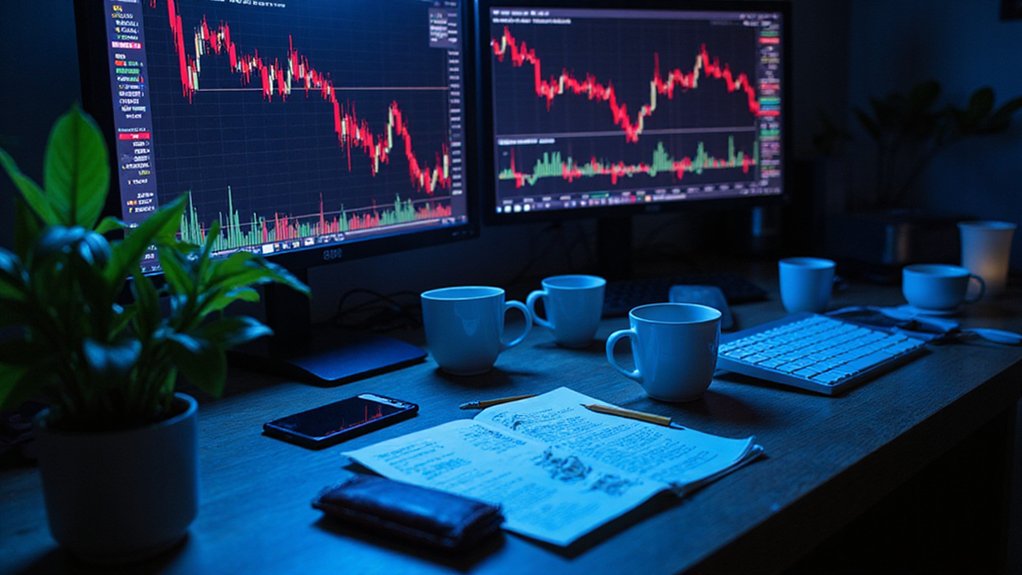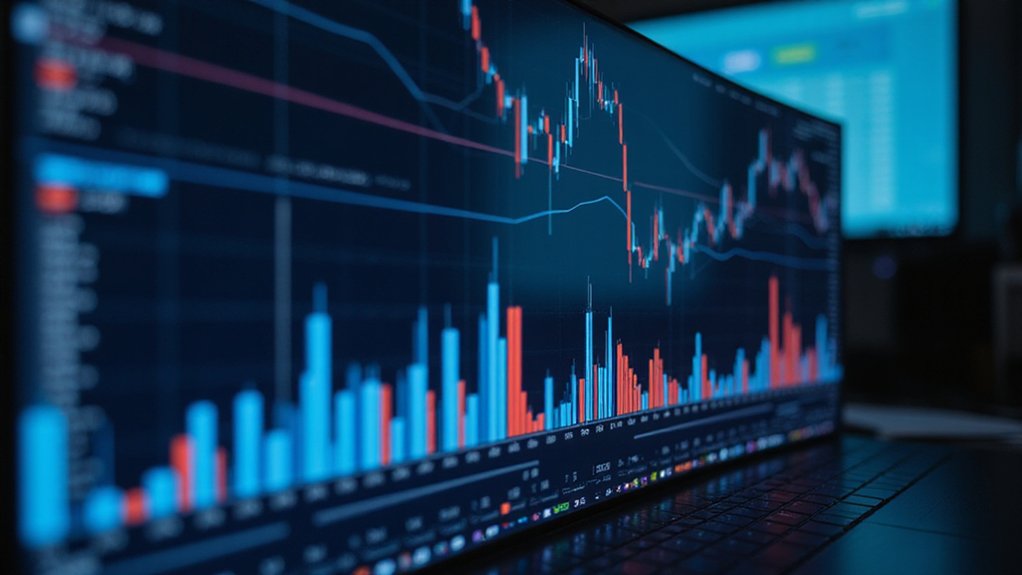Cryptocurrency day trading demands technical prowess and iron discipline—a high-risk pursuit where only 1% consistently profit. Successful traders identify market trends through candlestick patterns, employ momentum indicators like RSI and MACD, and religiously practice risk management (limiting exposure to 1-2% per position). The 24/7 market offers unique opportunities amid algorithmic competition, though the cascade of liquidations in 2022 serves as a sobering reminder. The difference between ruin and reward often lies in the technical frameworks one masters.

How does one navigate the dizzying world of cryptocurrency day trading, where fortunes can materialize—or evaporate—with unsettling rapidity?
The process begins with developing a keen sense for market trends, the currents that carry asset values toward their next destination.
Successful traders recognize both bullish and bearish movements, utilizing tools like moving averages and pattern recognition to anticipate price direction before committing capital.
Technical analysis forms the backbone of most cryptocurrency trading strategies.
Technical analysis acts as the skeletal framework supporting the body of modern crypto trading methodologies, separating intuition from insight.
Experienced traders parse candlestick formations with the diligence of ancient scholars interpreting sacred texts, identifying support and resistance levels that function as invisible boundaries in the market’s collective psychology. Understanding the three main components of candlesticks—color, real body, and wicks—provides critical insights into price action and market sentiment.
The RSI and MACD—those stalwarts of momentum analysis—provide vital data points regarding overbought or oversold conditions, while volume confirmation separates genuine breakouts from elaborate bull traps.
The arsenal of day trading approaches continues to evolve alongside the market itself.
Scalping—that rapid-fire strategy of accumulating microscopic profits through high-frequency trading—attracts those with faster reflexes, while range traders patiently await assets to bounce between established price corridors.
Momentum traders, meanwhile, ride the waves of market sentiment, disembarking before inevitable corrections materialize.
Arbitrage and reversal trading round out this tactical repertoire, each appealing to different risk appetites and analytical strengths.
Risk management represents the difference between longevity and liquidation in this unforgiving arena.
The disciplined trader limits exposure to 1-2% per position, sets automated stop-losses, and analyzes past performance with scientific detachment.
Selecting appropriate cryptocurrencies further tilts probability toward success—liquidity and volatility forming the twin pillars of opportunity, while fundamental analysis prevents entanglement with fundamentally flawed projects.
Technology extends human capabilities through trading bots that execute strategies with algorithmic precision, though these tools demand vigilant monitoring lest they malfunction spectacularly during unexpected market conditions.¹
The fusion of technical insight, strategic diversity, psychological discipline, and technological leverage ultimately determines who profits consistently in cryptocurrency’s perpetual price discovery.
The 24/7 market operation creates unique opportunities for traders in different time zones to capitalize on price movements that traditional markets cannot provide.
The sobering reality is that an overwhelming majority of day traders lose money, with studies suggesting that only about 1% remain profitable after accounting for trading fees and other expenses.
¹A lesson many learned during 2022’s cascade of liquidations.
Frequently Asked Questions
What Tax Implications Should I Prepare for When Day Trading Cryptocurrency?
Day traders face onerous tax burdens: each trade constitutes a taxable event, typically generating short-term capital gains taxed at ordinary income rates (up to 37%).
The IRS’s property classification means meticulous transaction documentation is non-negotiable.
Form 8949 becomes one’s constant companion, while the wash sale rule’s applicability remains ambiguous¹.
Tax software specializing in cryptocurrency seems less luxury than necessity, given the computational labyrinth that awaits.
¹Though technically unclear for crypto, prudence suggests assuming it applies.
How Do I Manage Emotions During Volatile Cryptocurrency Trading Sessions?
Managing emotions during volatile trading requires establishing a structured framework—essentially, a psychological circuit breaker.
Traders should implement concrete rules (stop-losses, position sizing limits) that override emotional impulses, maintain trading journals to identify emotional triggers, and practice mindfulness techniques to create mental distance from market fluctuations.
The most successful traders aren’t those who never feel fear or greed—they’re simply those who’ve mastered the art of not acting upon them.
Should I Use Leverage When Day Trading Cryptocurrencies?
Leveraged trading, while potentially lucrative, represents financial Russian roulette for most retail traders.
The amplified volatility in crypto markets—where 20% daily swings aren’t uncommon—renders high leverage particularly hazardous.
Novices should avoid it entirely; experienced traders might consider minimal leverage (2-3x) with strict risk management protocols.
The stark reality? Even seasoned professionals frequently miscalculate, facing liquidation when markets move counterintuitively.
Emotional discipline, already challenging, becomes exponentially harder with leverage in play.
What Backup Plans Exist if Exchanges Go Down Mid-Trade?
When exchanges falter mid-trade, prudent traders deploy multi-layered contingencies.
Diversification across platforms allows for rapid pivoting when one venue fails.
Cold storage wallets safeguard assets during downtime, while pre-established hedge positions mitigate exposure risks.
Sophisticated traders utilize bots with cross-exchange functionality to reroute orders automatically.
Exchange-independent communication channels provide critical status updates, enabling swift decision-making during those moments when Murphy’s Law inevitably materializes in digital asset markets.
How Do Regulatory Changes Affect Cryptocurrency Day Trading Strategies?
Regulatory changes ripple through day trading strategies with both subtle and seismic effects.
Traders must pivot nimbly as new compliance requirements alter execution speeds, tax policies reshape profitability calculations, and jurisdictional bans force market migrations.
The savvy operator maintains a regulatory radar that’s perpetually scanning—adjusting position sizes, revising risk parameters, and recalibrating algorithmic strategies to capitalize on the volatility that inevitably follows governmental pronouncements (often paradoxically creating opportunity amid constraint).









